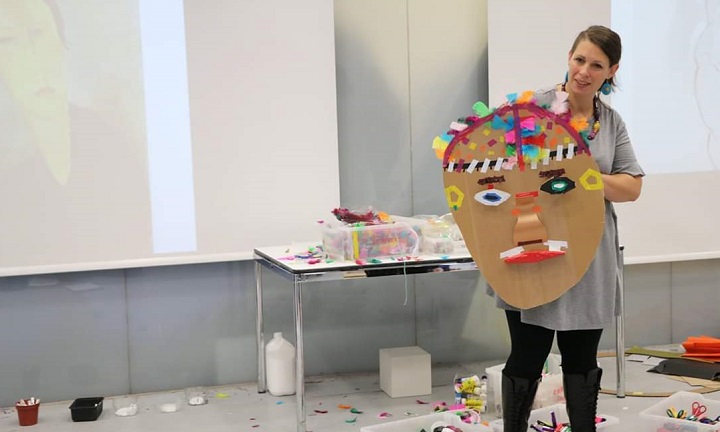Rach Anstey-Sanders is an artist and educator working in the Sainsbury Centre Learning team. She explores what creative play is and why it's so important for young people and adults alike. She writes that, in these uncertain times, she's started to discover beauty in the chaos.

I’m sitting in my ‘COVID-19 office’ in the corner of our bedroom listening to my children, she aged six and he four, engage in an imaginary game. My daughter is in charge. My son is her pet. There is a lead involved, so possibly a dog (I know this because I took a break to check the strangulation potential). I hear some mournful words. ‘Sorry, the park’s closed. We can’t go there today.’ He is dramatic and also currently obsessively interested in where is closed and where is open. She, ever the practical problem solver, responds brightly. ‘Oh, it’s ok. We will just go for a nice walk! Shall we go to the woods?’
As person and pet head off towards the trees I reflect on how this illustrates two ways children – and adults – use creativity. Firstly to deal with the ‘here and now'. That is: adapting to the challenges in changing times. And secondly, to escape – to create a space to breathe in times that can seem suffocating. That's all very apt for circumstances we find ourselves in, but why does creative play matter so much? And what is it anyway?
The word ‘creative’ can refer to the creation of art, other examples of creativity could be found in the expression of an idea, or ways to solve a problem. We are all capable of creativity taken in this broad sense although we may lack the tools with which to express ourselves.
The term ‘creative play’ is the time and space in which we explore, hone and use those tools. They could be physical skills but also confidence and language to explain what is being generated.
Creative play is not limited to specific types of activity. My daughter was engaged in creative play this morning when she decided to make herself a yoghurt and fruit sandwich for breakfast. (I am informed it was delicious.) Whereas my son was playing creatively when he made slow, deliberate footprints in the sand pit. And we were all doing it when we took turns to make up our own silly words to ‘My Bonnie Lies Over the Ocean’.
So how do we set the scene for creative play to happen? One way is to establish useful skill sets for children through appropriate and appealing activities. Practical skill and experience are vital fuels for creativity. During the last few weeks the learning team at the Sainsbury Centre have been working with our associate artists to deliver some exciting art activities to a device near you. If you are looking for inspiration our new Online Studio could be a good place to start.
Another important ingredient of creative play is nurturing an ethos where experimentation, with all its potential ‘failures', is ok, and where reflection is part of the process. It helps if outcomes are flexible (participants control when to modify and when to finish) and activities have room to breathe. A tip: before starting a creative activity on the dining table make sure it can be moved if the table is needed before it reaches its conclusion.
While planning activities with artists at the Sainsbury Centre before lockdown, I found it helpful to include questions which a participating adult could ask. This can help children to frame their ideas in a process of reflection during the creative process and evaluation at the end. At home, of course, I never prepare a list, but it’s good to get into the habit of asking questions aloud, both of yourself as a participant (‘I wonder if...’, or ‘Hmm that didn’t work. What should I do now?’) and of children. Ask: ‘You chose to use yellow – I wonder what that will look like.’ ‘Did that work out how you planned?’ ‘What does that remind you of?’
If all else fails, be guided by your child’s interests. There’s no one way to do creative play. In fact, I’m sure you already do it! Sometimes, however, knowing what is going on can help you support your child in thinking creatively, experimenting, making connections and learning as they go.
Get more top tips from Rach through Facebook and Instagram. And, if you have a story to share, please email communications@uea.ac.uk
)
)
:focus(1803x1718:1804x1719))